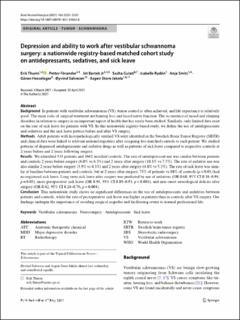| dc.description.abstract | Background In patients with vestibular schwannomas (VS), tumor control is often achieved, and life expectancy is relatively good. The main risks of surgical treatment are hearing loss and facial nerve function. The occurrence of mood and sleeping disorders in relation to surgery is an important aspect of health that has rarely been studied. Similarly, only limited data exist on the rate of sick leave for patients with VS. In this nationwide registry-based study, we define the use of antidepressants and sedatives and the sick leave pattern before and after VS surgery. Methods Adult patients with histopathologically verified VS were identified in the Swedish Brain Tumor Registry (SBTR) and clinical data were linked to relevant national registries after assigning five matched controls to each patient. We studied patterns of dispensed antidepressants and sedative drugs as well as patterns of sick leave compared to respective controls at 2 years before and 2 years following surgery. Results We identified 333 patients and 1662 matched controls. The rate of antidepressant use was similar between patients and controls 2 years before surgery (6.0% vs 6.3%) and 2 years after surgery (10.1% vs 7.5%). The rate of sedative use was also similar 2 years before surgery (3.9% vs 4.3%) and 2 years after surgery (4.8% vs 5.3%). The rate of sick leave was similar at baseline between patients and controls, but at 2 years after surgery, 75% of patients vs 88% of controls (p < 0.01) had no registered sick leave. Long-term sick leave after surgery was predicted by use of sedatives (OR 0.60, 95% CI 0.38–0.94, p = 0.03), more preoperative sick leave (OR 0.91, 95% CI 0.89–0.93, p < 0.001), and new-onset neurological deficits after surgery (OR 0.42, 95% CI 0.24–0.76, p = 0.004). Conclusion This nationwide study shows no significant differences in the use of antidepressants and sedatives between patients and controls, while the rate of postoperative sick leave was higher in patients than in controls after VS surgery. Our findings underpin the importance of avoiding surgical sequelae and facilitating return to normal professional life. | en_US |

